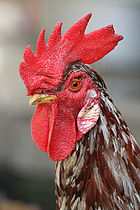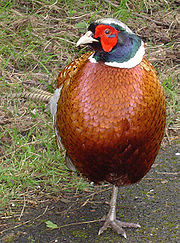.gif)
Wattle (anatomy)
Encyclopedia


A wattle is a fleshy dewlap
Dewlap
A dewlap is a longitudinal flap of skin that hangs beneath the lower jaw or neck of many vertebrates. While the term is usually used in this specific context, it can also be used to include other structures occurring in the same body area with a similar aspect, such as those caused by a double...
or caruncle
Caruncle
Caruncle may refer to:*In botany, an elaiosome , especially in the plant family Euphorbiaceae*In animal anatomy:**prostomium, the sensory organ of Annelid worms...
hanging from various parts of the head or neck in several groups of birds, goats and other animals. In some birds the caruncle is erectile tissue
Erectile tissue
Erectile tissue is tissue in the body that can become erect, usually by becoming engorged with blood.-Erectile tissue in the clitoris and penis:...
.
The wattle is frequently an organ of sexual dimorphism
Sexual dimorphism
Sexual dimorphism is a phenotypic difference between males and females of the same species. Examples of such differences include differences in morphology, ornamentation, and behavior.-Examples:-Ornamentation / coloration:...
. In some cases within the bird world the caruncle has a feather covering, whilst in other cases the feathers are sparse or absent.
Function
In birds the wattle is often an ornament for courting potential matesSexual selection
Sexual selection, a concept introduced by Charles Darwin in his 1859 book On the Origin of Species, is a significant element of his theory of natural selection...
. A large wattle is correlated with high testosterone levels, good nutrition, and the ability to evade predators, which in turn suggests a successful mate. It has also been proposed that ornamental organs such as the wattle are also associated with genes
Gene
A gene is a molecular unit of heredity of a living organism. It is a name given to some stretches of DNA and RNA that code for a type of protein or for an RNA chain that has a function in the organism. Living beings depend on genes, as they specify all proteins and functional RNA chains...
coding for disease resistance.
Examples
BirdBird
Birds are feathered, winged, bipedal, endothermic , egg-laying, vertebrate animals. Around 10,000 living species and 188 families makes them the most speciose class of tetrapod vertebrates. They inhabit ecosystems across the globe, from the Arctic to the Antarctic. Extant birds range in size from...
s with wattles include:
- From the neck or throat
- Birds of the family Casuarius: the Northern, Southern, and Dwarf cassowaries
- GalliformesGalliformesGalliformes are an order of heavy-bodied ground-feeding domestic or game bird, containing turkey, grouse, chicken, New and Old World Quail, ptarmigan, partridge, pheasant, and the Cracidae. Common names are gamefowl or gamebirds, landfowl, gallinaceous birds or galliforms...
(e.g., wild turkeyWild TurkeyThe Wild Turkey is native to North America and is the heaviest member of the Galliformes. It is the same species as the domestic turkey, which derives from the South Mexican subspecies of wild turkey .Adult wild turkeys have long reddish-yellow to grayish-green...
s, chickenChickenThe chicken is a domesticated fowl, a subspecies of the Red Junglefowl. As one of the most common and widespread domestic animals, and with a population of more than 24 billion in 2003, there are more chickens in the world than any other species of bird...
s) - Some vultureVultureVulture is the name given to two groups of convergently evolved scavenging birds, the New World Vultures including the well-known Californian and Andean Condors, and the Old World Vultures including the birds which are seen scavenging on carcasses of dead animals on African plains...
s - Some lapwingLapwingVanellinae are any of various crested plovers, family Charadriidae, noted for its slow, irregular wingbeat in flight and a shrill, wailing cry. Its length is 10-16 inches. They are a subfamily of medium-sized wading birds which also includes the plovers and dotterels. The Vanellinae are...
s - Some Australian wattlebirdWattlebirdWattlebirds are members of the Honeyeater family, and native to Australia. Species of wattlebird include the Little Wattlebird, the Red Wattlebird, the Western Wattlebird, and the Yellow Wattlebird....
s (Anthochaera spp.) - The New Zealand wattlebirdsCallaeidaeThe small bird family Callaeidae is endemic to New Zealand. It contains three monotypic genera; of the three species in the family, only two survive and both of them, the Kokako and the Saddleback, are endangered species, threatened primarily by the predations of introduced mammalian species such...
(Callaeidae), which include the KokakoKokakoThe Kōkako is a forest bird which is endemic to New Zealand. It is slate-grey with wattles and a black mask. It is one of three species of New Zealand Wattlebird, the other two being the endangered Tieke and the extinct Huia...
, Tieke or SaddlebackTiekeThe Saddleback or Tieke is a previously rare and endangered New Zealand bird of the family Callaeidae. It is glossy black with a chestnut saddle. Its taxonomic family is also known as that of the "wattlebirds" and includes the two subspecies of the Kokako as well as the extinct Huia...
, and the HuiaHuiaThe Huia was the largest species of New Zealand wattlebird and was endemic to the North Island of New Zealand. Its extinction in the early 20th century had two primary causes. The first was rampant overhunting to procure Huia skins for mounted specimens, which were in worldwide demand by...
- From below the eyes
- The African Wattle-eye or Puffback FlycatcherWattle-eyePlatysteiridae is a family of small stout passerine birds of the African tropics. The family contains the wattle-eyes, batises and shrike-flycatchers. They were previously classed as a subfamily of the Old World flycatcher family Muscicapidae.These insect-eating birds are found in usually open...
- Many male pheasantPheasantPheasants refer to some members of the Phasianinae subfamily of Phasianidae in the order Galliformes.Pheasants are characterised by strong sexual dimorphism, males being highly ornate with bright colours and adornments such as wattles and long tails. Males are usually larger than females and have...
s - Spectacled TyrantSpectacled TyrantThe Spectacled Tyrant is a species of bird in the Tyrannidae family, the only one in the genus Hymenops.It is found in Argentina, Bolivia, Brazil, Chile, Paraguay, Peru, and Uruguay....
- The African Wattle-eye or Puffback Flycatcher
Mammals
MammalMammal
Mammals are members of a class of air-breathing vertebrate animals characterised by the possession of endothermy, hair, three middle ear bones, and mammary glands functional in mothers with young...
s with wattles include:
- Many domestic goatGoatThe domestic goat is a subspecies of goat domesticated from the wild goat of southwest Asia and Eastern Europe. The goat is a member of the Bovidae family and is closely related to the sheep as both are in the goat-antelope subfamily Caprinae. There are over three hundred distinct breeds of...
s, as a fleshy protuberance hanging either side of the throat - Some domestic pigPigA pig is any of the animals in the genus Sus, within the Suidae family of even-toed ungulates. Pigs include the domestic pig, its ancestor the wild boar, and several other wild relatives...
s (such as most kunekuneKunekuneThe kunekune is a small breed of domestic pig from New Zealand. Kunekune are hairy, and have a dumpy build and can have wattles hanging from their lower jaw. Colour ranges include black and white, ginger, cream, gold-tip, black, brown and tri-coloured...
s), as a fleshy protuberance hanging either side of the throat

